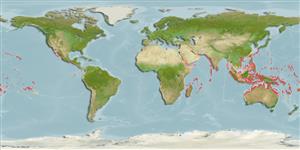Common names from other countries
Environment: milieu / climate zone / depth range / distribution range
Οικολογία
Θαλασσινό(ά) Υφαλόφιλο(α); εύρος βάθους 0 - 20 m (Ref. 9770). Tropical; 30°N - 32°S
Indo-Pacific: Red Sea south to East Africa through Indonesia and northern Australia up to Hawaii and Pitcairn islands; north to southern Japan.
Μέγεθος / Βάρος / Age
Maturity: Lm ? range ? - ? cm
Max length : 30.0 cm TL αρσενικό/απροσδιόριστο; (Ref. 30573)
Ραχιαίες άκανθες (συνολικά) : 3; Μαλακές ραχιαίες ακτίνες (συνολικά) : 22 - 25; Εδρικές άκανθες: 0; Μαλακές εδρικές ακτίνες: 20 - 22. Body orange-brown above; head and belly white; soft dorsal, anal and pectoral fins pale; caudal fin dusky (Ref. 4420).
Occur in shallow outer reefs subject to surge (Ref. 9770, 48637). Commonly found over barren rock or the spur-and-groove zone where there is a mixture of bare rock, rubble, and coral. Juveniles on algae reef (Ref. 48637). Benthopelagic (Ref. 58302). Feed on algae, detritus, mollusks, crustaceans, worms, echinoderms, fishes, sponges, foraminiferans, and eggs. Territorial. Oviparous (Ref. 205). Also taken by drive-in nets (Ref. 9770). Minimum depth reported taken from Ref. 128797.
Life cycle and mating behavior
Maturities | Αναπαραγωγή | Spawnings | Egg(s) | Fecundities | Προνύμφες
Distinct pairing (Ref. 205).
Matsuura, K., 2001. Balistidae. Triggerfishes. p. 3911-3928. In K.E. Carpenter and V. Niem (eds.) FAO species identification guide for fishery purposes. The living marine resources of the Western Central Pacific. Vol. 6. Bony fishes part 4 (Labridae to Latimeriidae), estuarine crocodiles. FAO, Rome. (Ref. 9770)
IUCN Red List Status (Ref. 130435)
CITES (Ref. 128078)
Not Evaluated
Threat to humans
Harmless
Human uses
αλιεία: περιορισμένης εμπορικότητας; Ενυδρείο: Εμπορικό(ά)
Εργαλεία
Special reports
Download XML
Διαδικτυακές πηγές
Estimates based on models
Preferred temperature (Ref.
115969): 24.8 - 29.3, mean 28.3 (based on 2985 cells).
Phylogenetic diversity index (Ref.
82804): PD
50 = 0.5078 [Uniqueness, from 0.5 = low to 2.0 = high].
Bayesian length-weight: a=0.02570 (0.01489 - 0.04438), b=2.92 (2.77 - 3.07), in cm Total Length, based on LWR estimates for this species & (Sub)family-body (Ref.
93245).
Τροφικό Επίπεδο (Ref.
69278): 3.5 ±0.3 se; based on diet studies.
Ελαστικότητα (Ref.
120179): Μεσαίο(α), ελάχιστος χρόνος για διπλασιασμό πληθυσμού 1,4 - 4,4 έτη (Preliminary K or Fecundity.).
Fishing Vulnerability (Ref.
59153): Low vulnerability (20 of 100).
